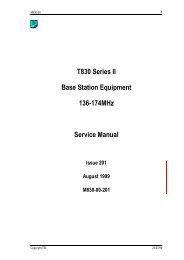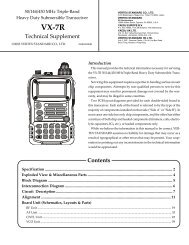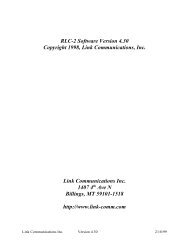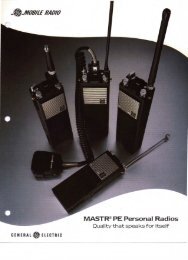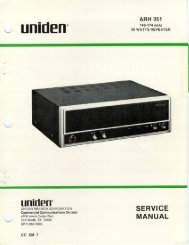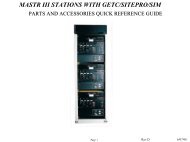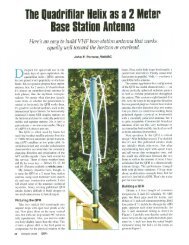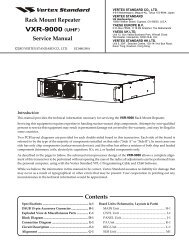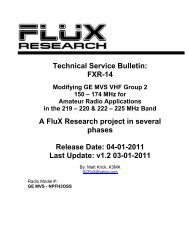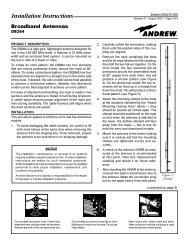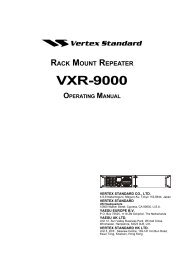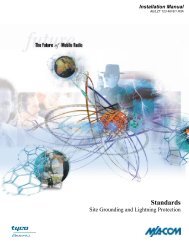TK-880/H (UHF) mobile service manual - The Repeater Builder's ...
TK-880/H (UHF) mobile service manual - The Repeater Builder's ...
TK-880/H (UHF) mobile service manual - The Repeater Builder's ...
You also want an ePaper? Increase the reach of your titles
YUMPU automatically turns print PDFs into web optimized ePapers that Google loves.
OPERATING FEATURES<br />
<strong>TK</strong>-<strong>880</strong>/H<br />
■ “TOT” reset time<br />
<strong>The</strong> transceiver has “TOT” reset timer. This timer is the<br />
minimum wait time allowed during a transmission that will<br />
reset the “TOT” count.<br />
“TOT” reset time causes the “TOT” to continue even<br />
after PTT is released unless the “TOT” reset timer has expired.<br />
■ OST (Operator Selectable Tone)<br />
<strong>The</strong> transceiver is capable to have “OST” function and 16<br />
tone pair (QT/DQT) with max 10-digit name for each tone<br />
pair.<br />
■ “OST” back up<br />
<strong>The</strong> transceiver is programmable the selected “OST”<br />
code is memorized or not. If you set to Disable (no memorized),<br />
the “OST” function always starts at “off”.<br />
■ Direct “OST”<br />
It is possible to call “OST” number directory using keypad.<br />
In this case, keypad is used for “OST”, then auto<br />
“PTT” store and send functions by keypad are not usable.<br />
■ Clear to transpond<br />
<strong>The</strong> transceiver waits the transpond of 2-tone /DTMF if<br />
channel is busy until channel open. This feature prevents<br />
the interference to other party.<br />
5. Option Signalling<br />
5-1. DTMF/2-Tone<br />
Built-in DTMF decoder is available for option signalling.<br />
Built-in 2-tone decoder is available for option signalling.<br />
It is possible to use individual call, group call, D.B.D.<br />
(Dead Beat Disable). D.B.D. is used with DTMF only.<br />
If the option signalling matches, a predetermined action<br />
will occur.<br />
If option signalling matches on a group/channel which is<br />
set up with option signalling, the option signalling indicator<br />
( ) will flash and option signalling will be released. <strong>The</strong><br />
*<br />
transpond or alert tone will sound.<br />
If the selective call alert LED is set up, the orange LED<br />
will flash.<br />
While option signalling matches (or if option signalling is<br />
deactivated when you are transmitting), you can mute or<br />
unmute ID/QT/DQT/Carrier.<br />
■ AND/OR<br />
You can select AND or OR for option signalling match<br />
conditions.<br />
Alert/Transpond<br />
AND QT/DQT/ID+DTMF (2-tone); Option matches = Action<br />
OR QT/DQT/ID+DTMF (2-tone); Option matches = Action<br />
AF mute open<br />
AND QT/DQT/ID+DTMF (2-tone); Option matches = Action<br />
OR QT/DQT/ID; Signalling only matches = Action<br />
With OR set up, alert/transpond will not function with<br />
only DTMF (Trunking format).<br />
With OR set up, AF mute will not release when only<br />
DTMF matches.<br />
With a conventional channel not set up with QT or DQT,<br />
only the carrier is considered when signalling matches.<br />
■ Auto Reset<br />
If option signalling matches a group set up with option<br />
signalling, option signalling is released. After matching option<br />
signalling, option signalling will temporarily reset automatically.<br />
■ Dead Beat Disable<br />
If the D.B.D. code matches, a predetermined action will<br />
occur. Whether option signalling is activated or not, when<br />
D.B.D. matches on any channel, the transceiver will become<br />
TX inhibited or TX/RX inhibited. While D.B.D. is active, if the<br />
D.B.D. code + “#” code is received, D.B.D. will disactivate.<br />
When D.B.D. matches, transpond will function. Alert will<br />
not be output, and option signalling match icon will not appear.<br />
5-2. MSK<br />
Built-in MSK (FleetSync : Fleet-ID) decoder is available<br />
for option signalling. When the group ID/Carrier matches,<br />
squelch remains muted while the station waits for reception<br />
of proper MSK signal. When MSK signal matches, squelch<br />
unmutes.<br />
■ AND/OR<br />
AND : QT/DQT/ID + MSK to unmute. MSK matches =<br />
alert tone<br />
OR : QT/DQT/ID to unmute. MSK matches = alert tone<br />
6. Alphanumeric Two-way Paging Function<br />
(FleetSync)<br />
■ General<br />
<strong>The</strong> Alphanumeric Two-way Paging Function<br />
(FleetSync) is a KENWOOD proprietary protocol. It enables<br />
a variety of paging functions.<br />
■ ID Construction<br />
A radio unit ID is defined by a combination of 3-digit Fleet<br />
and 4-digit ID numbers. Each radio unit must be assigned its<br />
own Fleet and ID numbers.<br />
■ PTT ID<br />
A pre-programmed unique ID (own) can be sent at the<br />
beginning of transmission and/or the end of transmission to<br />
identify which radio unit is on air.<br />
When selecting (sel) for MSK ID, the radio calls the specific<br />
Fleet user the same as selective call.<br />
11



